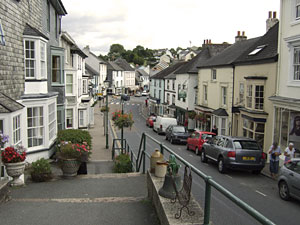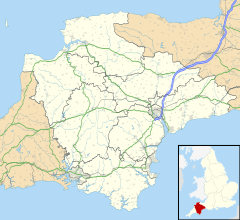Modbury facts for kids
Quick facts for kids Modbury |
|
|---|---|
 Church Street, Modbury |
|
| Population | 1,454 (2001) |
| OS grid reference | SX63835946 |
| • London | 181 mi (291 km) |
| Civil parish |
|
| District | |
| Shire county | |
| Region | |
| Country | England |
| Sovereign state | United Kingdom |
| Post town | IVYBRIDGE |
| Postcode district | PL21 |
| Dialling code | 01548 |
| Police | Devon and Cornwall |
| Fire | Devon and Somerset |
| Ambulance | South Western |
| EU Parliament | South West England |
| UK Parliament |
|
| Website | Modbury Parish Council website |
Modbury is a large village in the South Hams area of Devon, England. Even though it's called a village, many people think of it as a small town because of its size. It's also known as a "market town" because, for a very long time, the local lord had the right to hold a regular market here.
Modbury is located on the A379 road. This road connects the village to bigger places like Plymouth and Kingsbridge. About 1,500 people live in Modbury today.
Contents
What Does Modbury Mean?
The name Modbury comes from an old Anglo-Saxon name, Moot burgh. 'Moot' might mean 'Mud' or 'meeting'. 'Bury' means a 'fortified enclosure' or a strong, protected place. So, Modbury could mean a "muddy fort" or a "meeting fort".
Modbury's Past: A Look Back
Modbury is mentioned in a very old book called the Domesday Book from 1086. This book was a big survey of England ordered by William the Conqueror. The village has been allowed to hold a weekly fair since before the year 1199.
Sadly, the number of people living in Modbury dropped a lot in the 1300s. This was because of a terrible disease called the Black Death.
Battles During the English Civil War
Modbury was the site of two important battles during the English Civil War. This war was fought in England between 1642 and 1651. It was between the Parliamentarians (who supported Parliament) and the Royalists (who supported the King).
The first battle happened on December 7, 1642. Parliamentarian soldiers made a surprise attack on Modbury. They moved secretly from Plymouth at night. They defeated the Royalist forces who were gathered in the village. The Royalist leader, Sir Ralph Hopton, escaped. But many important Royalists from Devon were captured.
The second Battle of Modbury took place on February 22, 1643. The Royalists had made the town strong, expecting an attack. But they were outnumbered and running out of ammunition. They had to retreat. This victory was very important. It helped to end the attack on Plymouth and pushed the Royalist forces back into Cornwall.
Life in the 1800s
By 1801, Modbury's population had grown to 1,813 people. Almost half of them worked in the wool trade. But new machines changed how wool was made. This had a big effect on Modbury's economy and population from the 1820s. Many workers left the village to find jobs in bigger cities. Some even moved to America.
The railway line was built, but it didn't go through Modbury. This also made the village's economy decline further. Modbury remained an important market town until 1944, when its cattle market closed.
Modbury Manor: A Historic Estate
The main estate in Modbury, called the manor of Modbury, was owned by several important families over time. It started with the Vautort family after the Domesday Book. Later, it passed to the Okeston family and then to the Champernowne family.
The old manor house, called "Court House," was near the church. It was destroyed during the English Civil War. The parts that were left were sold for building materials in 1705.
The name Modbury Manor also inspired the name of a town in New England, USA. This town is called Madbury, New Hampshire.
St George's Church: A Village Landmark
The parish Church of St George is a very old and important building. Most of the church was built in the 1300s. It has a tall tower with a pointed roof called a spire. People believe the spire was hit by lightning in 1621 and then rebuilt.
The church's roofs were repaired in the 1500s. In 2013, the church was put on a list of historic places at risk because of roof damage and damp. But thanks to a grant in 2015, a lot of repair work was done to restore the roof and other parts of the church.
Historic Estates Around Modbury
Modbury parish has several other historic estates.
Little Modbury
Little Modbury was once a large estate. In the 1700s, it was divided into smaller parts. Today, it's just an area south of the village, though Little Modbury Farm still keeps the old name.
Shilstone Manor
Shilstone Manor is a restored old house just outside Modbury village. It was mentioned in the Domesday Book. The Hill family owned it from the late 1300s. Later, the Savery family took over the estate.
In the 1900s, the house was in bad condition and used as a farmhouse. But in the early 2000s, it was beautifully restored to how it looked in the Georgian era. This restoration won several awards. The historic gardens at Shilstone have also been brought back to life.
An English inventor named Thomas Savery was born around 1650 at the old manor house at Shilstone. He invented one of the first steam-powered devices, a steam pump.
Wympston
Whympston is another historic estate in Modbury parish. King John gave this estate to John Fortescue in 1209. It became the first home in England for the very important Fortescue family. This family is still well-known today.
Yarnacombe
Yarnacombe is also a historic estate in Modbury. It once belonged to the Hart Family.
Modbury's Plastic Bag Ban
In April 2007, shops in Modbury decided to stop giving out plastic bags to customers. They did this to help the environment. This idea was very popular and inspired other communities in England to do the same thing.
Modbury Rovers Junior F.C.
Modbury has a recreation field. It has a football pitch, tennis courts, and an all-weather surface for skateboarding. This is the home of Modbury Rovers, a junior football club. They play in local leagues and competitions.
Famous People From Modbury
Several notable people were born in or lived near Modbury:
- Katherine 'Kat' Ashley (died 1565) was a governess to Queen Elizabeth I. She was likely born in or near Modbury.
- Sir George Baker, 1st Baronet (1722–1809) was a doctor to King George III. He was born in Modbury.
- William Battie (died 1776), who was president of the Royal College of Physicians in 1764, was also born in the village.
- Thomas Savery (c. 1650–1715) was an inventor. He created one of the first commercially used steam-powered devices, a steam pump. He was born at Shilstone, near Modbury.
See also
 In Spanish: Modbury para niños
In Spanish: Modbury para niños




